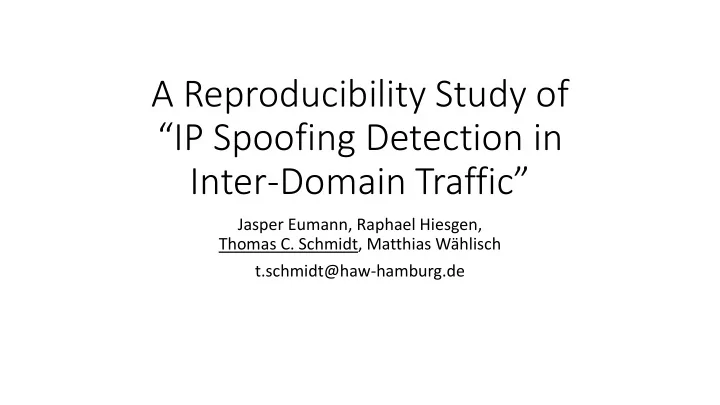

A Reproducibility Study of “IP Spoofing Detection in Inter-Domain Traffic” Jasper Eumann, Raphael Hiesgen, Thomas C. Schmidt, Matthias Wählisch t.schmidt@haw-hamburg.de
Spoofing Detection in Interdomain Traffic Starting Point: Our objective: • Lichtblau, Streibelt, Krüger, Richter, Feldmann: • Build a software infrastructure that can Detection, Classification, and Analysis of Inter- scrub spoofed traffic at IXPs in real-time Domain Traffic with Spoofed Source IP • First: Reproduce results with a different Addresses, IMC 2017 team, different setup, data and times Claim: • Method to passively detect spoofed Our approach: packets in traffic exchanged between networks in the inter-domain Internet • Iterate methods and (provided) scripts at that minimizes false positives a large regional IXP Application domain: IXP • Extend the analysis with additional BGP data sets and dig into classified traffic • Measurements and Analyses preformed at a large European IXP
The IMC‘17 Approach Idea: If a valid packet leaves an AS, it must originate from the routable cone of the emitting AS, i.e., belongs to a prefix reachable through it Three approaches to identify these cones: • Naïve: A prefix P is in the cone of AS A, iff A appears on a BGP path for P • CAIDA customer cone: All prefixes of customer ASes • Full cone: Extends the naïve cone by assuming transitive relations between all neighboring ASes for all prefixes
Classification Traffic types • Regular • Bogon: Private or multicast source addresses • Unrouted: Source addresses from unannounced IP space • Invalid: Classified as spoofed
Time Series for Classified Traffic
Packet Properties IMC’17 sees 90 % of invalid UDP traffic to port 123 (NTP)
Looking Deeper in our Invalid Traffic
Summary • Results of IMC’17 could not be reproduced • Particular discrepancies for Full Cone approach • Traffic classified as invalid appears mainly unspoofed • Majority of traffic seems HTTP(s) or Quick – not NTP or DNS • False positive indicators dominate • Our impression: determination of cones not accurate enough • BGP visibility too low • Authors of IMC’17 manually added peerings after traffic inspection • Approach seems unsuitable for operational deployment
Recommend
More recommend